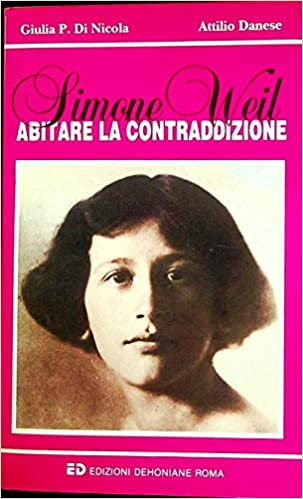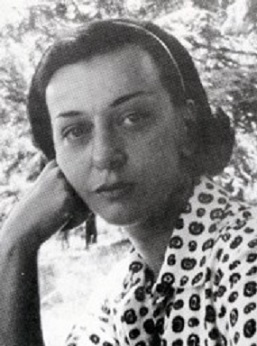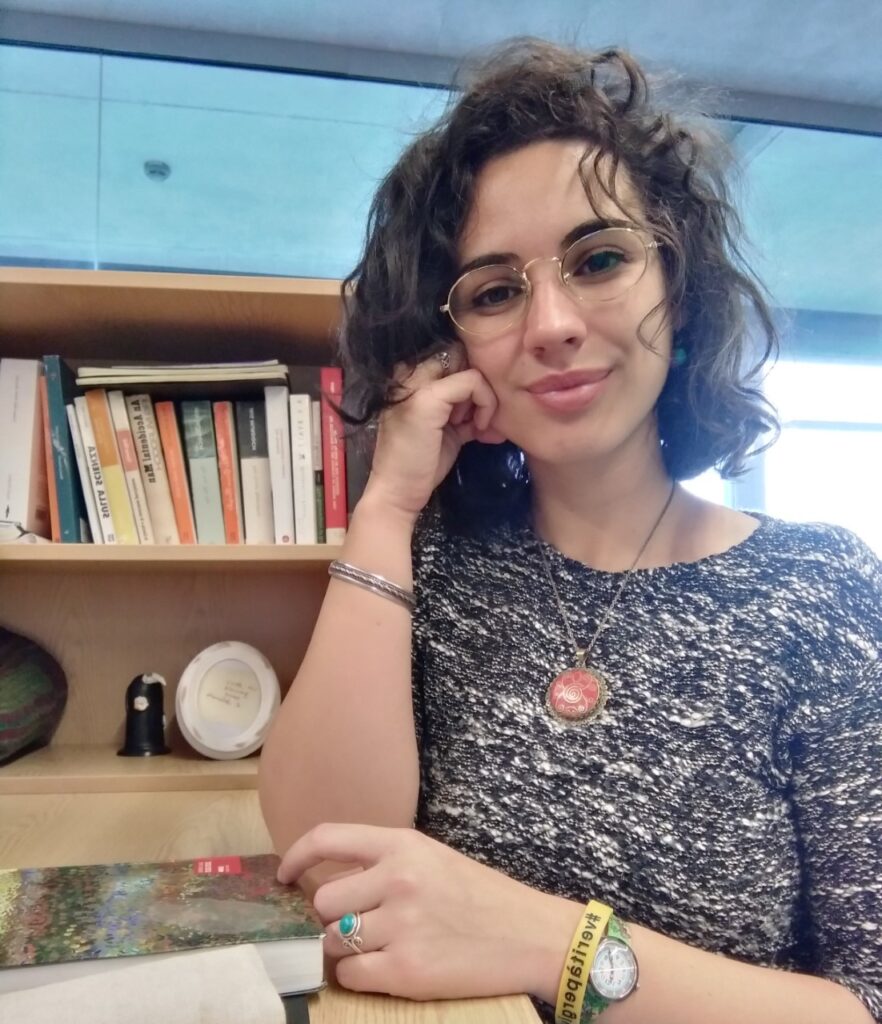News From Italy: Books, Articles & Events
Michela DianettiSimone Weil never stopped arousing interest in Italy since her works were first translated in the early 1950s. In Italy, as everywhere else, her philosophy was often utilized in different contexts and for different purposes (especially in theology and politics) and often misunderstood. Nonetheless, there is a consistent thread in Weilian studies — always more visible and present in Italy — that tries to frame her thought in its philosophical dignity and complexity.

New Translation: Perrin & Thibon, Simone Weil come l’abbiamo conosciuta (preface by Chiara Zamboni)
This growing interest accompanies a series of new editions of fundamental works, such as Simone Weil as We Knew Her, Simone Weil come l’abbiamo conosciuta. This new edition was published this year (2022) by Mimesis. Written in 1952 by Weil’s friends, the catholic Gustave Thibon and the Dominican Father Joseph-Marie Perrin, the book depicts Simone Weil in an open, often opposing, dialogue with them. The period of her philosophical speculation framed in this book spans the years 1940 and 1941 when Weil was in Marseilles waiting to go to the US, as she had to leave Nazi-occupied Paris. In those years, her religious tone intensifies and becomes one with her philosophical take from the previous years.

The new preface by Chiara Zamboni, Professor at the University of Verona, underlines, as in most of her works, the ‘continuity’ which links Weil before and after her ‘religious turn’ in 1937/1938. She defines that continuity as ‘il desiderio di verità’ (the desire for truth), as for Weil, she says: ‘la verità richiede intelligenza guidata da amore. Così l’amore per la bellezza del mondo, che l’aveva guidata fino a quel momento, diviene l’amore per Dio attraverso la bellezza del mondo’ (truth requires intelligence led by love. Therefore, the love for the beauty of the world, which had been leading her until that moment, becomes the love for God throughout the beauty of the world). The complexity of that ‘turn’, more a change of orientation that keeps its fundamental ground, is one of the most interesting and debated issues in Weil’s scholarship, and it is on that sense of ‘continuity’ that this present consideration of her thought seems to be built.

Zamboni defines Father Perrin’s and Thibon’s criticism as ‘una ferita aperta’ (an open wound) since it encompasses both admiration and rejection of Weil’s ideas. This, she adds, is what makes it fascinating: ‘il contrappunto non armonico tra le idee di Weil sull’esperienza religiosa e il commento che loro ne fanno’ (the non-harmonious counterpoint between Weil’s ideas about religious experience and the authors’ comments on them). They criticize her view of the Catholic Church as a historical institution of power, and especially her idea of implicit forms of spirituality that precede the approach to the religious sphere. Nonetheless, their criticisms go along with admiration. As Zamboni notes, Perrin seems to still want to change Weil’s mind, although he is writing seven years after her death, and Thibon in his criticism of Weil’s dualism between the world of necessity and God, cannot avoid noticing how she herself already talked about ‘bridges’, metaxù, between necessity and the supernatural, of which beauty is the most fundamental one.
Simone Weil protagonista della filosofia del Novecento. Ritrovare l’umano

Another notable exponent in Italian research on Weil is Massimiliano Marianelli, Professor of the History of Philosophy at the University of Perugia. He edited a 2020 issue of the journal Studium, Simone Weil protagonista della filosofia del Novecento. Ritrovare l’umano (SW as protagonist of 20th-century philosophy — rediscover the humane).
In this issue, several scholars present Weil’s philosophy in-depth, with a close look at Weil’s philosophical influences, allowing her thought to emerge as historically situated. Marianelli provides a brilliant analysis of the concept of l’hasard des événements as the space of possibility, the heart of Weil’s relational ontology. This view is based on that relation, which Marianelli identifies in the works of Emmanuel Gabellieri in France, and in Franco Castellana, Giovanni Trabucco, and himself in Italy. This view rejects a dualistic interpretation of Weil’s philosophy, as much as any monistic or Spinozian unity in her thought. Marianelli’s interpretation, as well as Gabellieri’s idea of a métaxologie, advocates the Weilian idea of multiple readings of reality, and focuses on the idea of an ontology based on relation in which metaxù are the keys to rethink and re-present Weil’s thought, and keys for a new conception of modernity motivated by relation and mediation.
This ‘relational’ hermeneutic extends to how Weil’s own thought is situated in relation to her historical times and philosophical influences, for instance, her relationship with Plato, Descartes, Kant, and especially her teacher Alain, as well as ancient Oriental wisdom and Ancient Greek thought.
In line with Weil’s hermeneutical approach to the history of philosophy, Marianelli is working on a series of textbooks on the history of philosophy – Anima, corpo, relazioni. Storia della filosofia da una prospettiva antropologica (Soul, Body, Relations. The History of Philosophy from an Anthropological Perspective), which will be edited by Massimiliano Marianelli, Letterio Mauro, Marco Moschini, and Giuseppe D’Anna. These textbooks will be published by Città nuova in 2022. (A future issue of Attention will contain an interview with Professor Marianelli and a description of these forthcoming books.)
In his introduction to Simone Weil protagonista Marianelli encourages a sort of ‘Weil renaissance’, in a renewed attention to the more purely philosophical dimension of Weil’s thought. From this perspective, Weil is read not as an isolated marginal philosopher, but as a philosopher whose attitude is ‘espressione di un sentire comune del Novecento, che apre a nuove prospettive ontologiche e ad una rilettura della modernità filosofica’ (336) (the expression of a common modality of perceiving the twentieth century, which opens to new ontological perspectives and to a reinterpretation of philosophical modernity).
In this sense, Marianelli is venturing — also through a forthcoming journal (which is currently calling for papers) — to do what Robert Chenavier has been doing in France with Cahiers Simone Weil, and what Attention aims to do, namely, to reintroduce Weil as an extraordinarily contemporary philosophical thinker, one decidedly not marginal but central to the history of philosophy.
Florence De Lussy, Simone Weil, trans. by Francesco Agnellini (Hoepli, Milano, 2019)

Florence De Lussy’s noteworthy introduction to Weil’s life and philosophy was published in 2019 by Hoepli. The book, titled Simone Weil, was translated by Francesco Agnellini. This work, accessible and suitable for non-scholars seeking a first encounter with Weil, fills a gap on the shelves of Italian libraries. De Lussy, a major French Weilian scholar, gives a concise and informed picture of Weil, interweaving her life with her work. (Her book was recently reissued for French readers.)
Some notable Weil Italian scholars
Unfortunately, Weil is not an easily-encountered author for philosophy students in Italian universities. Nonetheless, there are a few relevant texts on her life and/or thought that provide a rich introduction to the study of her philosophy in Italy. These include:
- G. Fiori, Simone Weil. Biografia di un pensiero (Garzanti, Milano, 1981) (Simone Weil, an Intellectual Biography);
- F. Castellana, Simone Weil: la discesa di Dio (Edizioni Dehoniane, Napoli, 1985) (Simone Weil: the Descent of God);

- G. P. Di Nicola, A. Danese, Simone Weil. Abitare la contraddizione (Edizioni Dehoniane, Roma, 1991) (Simone Weil: Living The Contradiction);
- W. Tommasi, Simone Weil: segni, idoli e simboli (Franco Angeli, Milano, 1993) (Simone Weil: Signs, Idols and Symbols);
- C. Zamboni, Interrogando la cosa. Riflessioni a partire da Martin Heidegger e Simone Weil (a cura dell’Istituto di Filosofia dell’Università di Verona, IPL, Milano, 1993) (Questioning the Thing. Reflections Starting with Martin Heidegger and Simone Weil);
- G. Trabucco, Poetica soprannaturale. Coscienza della verità in Simone Weil (Glossa, 1997) (Supernatural Poetics: Consciouness of Truth in Simone Weil);
- R. Fulco, Corrispondere al limite, Simone Weil il pensiero e la luce (Studium, Roma, 2002) (Corresponding to the Limit, Simone Weil: the Thought and the Light);
- M. Marianelli, La metafora ritrovata: miti e simboli nella filosofia di Simone Weil, Città Nuova (Roma, 2004) (The Rediscovered Metaphor: Myths and Symbols in Simone Weil’s Philosophy);

- and the last comprehensive work by Professor Giancarlo Gaeta, who edited the Italian edition of the four Notebooks: Leggere Simone Weil (Quodlibet, Macerata, 2018) (Reading Simone Weil).
Of course, there are others not mentioned that deserve the attention of an international audience.
Upcoming June event on Cristina Campo
- Cristina Campo Colloquy: Il senso preciso delle cose (e il loro centro altrove) [the precise meaning of things (and their center elsewhere] — University of Verona, June 7, 2022
While the first English translation of Venise Sauvée (translated by Silvia Panizza and Philip Wilson) was published by Bloomsbury in 2019, (read more here), in Italy a new colloquy on one of the most important Italian translators of Simone Weil, Cristina Campo (1923-1977) will take place in June at the University of Verona.

Campo provided the first Italian translations of The Iliad or the Poem of Force (1967) and Venise Saved (1963). She played a crucial role in the distribution of Weil’s thought in Italy during those years. She was a translator and also a writer and poet. Likewise, she wrote essays on many topics close to Weil’s philosophy, especially related to myths and folklore.
The colloquy is organized by Chiara Zamboni together with the Diotima Group (a focal point in Italy for the study of women philosophers, especially Simone Weil, and the concept of difference).
Concerning the topic of reading, translation, and the hermeneutical practice of the critic, Campo once wrote:
“Non sta il critico di fronte al suo poeta come il poeta di fronte ai richiami del proprio cuore? Per questo, al momento di parlarne, egli deve averlo già interamente subìto: restituirlo non come semplice specchio ma come un’eco appunto: carica e intrisa di tutto quel cammino percorso, nella natura, dall’una e dall’altra voce.“
“Is not the critic facing his poet like the poet facing the calls of his heart? For this reason, in the moment of speaking, he must have already entirely endured him: offer him back not as a simple mirror but as an echo: charged and impregnated of all that journey, through nature, from one voice to the other.”
C. Campo, Gli Imperdonabili, Adelphi, Milan, p. 145
The correspondences that we want to offer in Attention, at present, and in future issues, aim to give space to that Weilian echo, as Campo said, ‘charged and impregnated’ of various readings coming from different countries. It is meant to be a point of observation that juxtaposes an eye for what’s new on the Weilian horizon, in this case, in Italy, with a look back on major works from the last century up until now. This backward look will include philosophical essays, introductions, plays, poems, and novels about Weil or influenced by Weil, which often did not make it beyond the national borders, mostly due to the language gap. This will underline the influence, often dismissed or ignored, that Weil had, for instance, on many Italian intellectuals: Elsa Morante (1912-1985), Cristina Campo, and Giorgio Agamben, to name a few. Likewise, the hope is that it will bring to light, through the practice of translation (in its broader Weilian sense), studies such as the famous (famous only in Italy!) 1979 Introduction to Weil’s The Love of God by the Italian philosopher Augusto Del Noce (1910-1989).

Michela Dianetti is the Italy correspondent for Attention. She is a graduate student at the National University of Ireland (Galway). Her Ph.D. thesis is the first to compare the narrative works of Iris Murdoch and Elsa Morante. Its principal aim is to highlight the crucial influence Simone Weil’s philosophy had on the two authors, especially Weil’s idea of affliction. She is the Barbara Stevens Heusel Research Fund Fellow for 2022.
6 Recommendations
